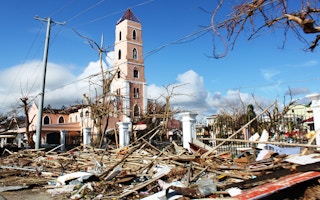As Super Typhoon Mangkhut nears the Philippines and Hong Kong, it’s clear that the world is witnessing an increase in the force and frequency of typhoons, especially in Asia.
Typhoon Jebi, the strongest typhoon to hit Japan in 25 years, paralysed major cities on the west coast. In China, Typhoon Rumbia battered Zhejiang Province in August, affecting nearly 9.5 million people. Hong Kong and Macau, which were hit hard last year when Typhoon Hato caused 10 deaths and HK$8 billion in losses, are braced for Super Typhoon Mangkhut to make its way towards the South China Sea in the next few days.
Research indicates that the economic cost of natural disasters like typhoons, super storms and flooding are rising globally. Major natural catastrophes in the 1990s are estimated to have caused an economic loss of US$66 billion per year. Compared to the 1950s, that’s a 15-fold increase. From 1994 to 2013, 6,730 disasters were reported, killing over 1.35 million people and costing the world economy about US$2.63 trillion.
Rethinking urban design
To combat the increase in the number of natural disasters and the amount of damage they wreak, we need to reconsider the way we build our cities. The areas increasingly at risk in terms of material damage and casualties or deaths are urban regions with a large population in a condensed area, such as Hong Kong. In cities, flooding from storm surges will be magnified, with heavy downpours sweeping the streets. So what can we do to typhoon-proof our cities?
One way of achieving this is through ‘sponge cities’. Most urban areas do not have the capacity to cope with lots of water for a short period of time until the typhoon has gone. But if cities can act like a sponge—meaning that they possess a sustainable drainage system that absorbs, captures, controls, and purifies water in its direct vicinity—they can manage excess rainfall and integrate it into the urban design.
Some cities are taking the threat seriously. Since 2016, Arcadis has been the principal consultant of China’s Wuhan sponge city pilot project, which reduces economic and environmental damage caused by pluvial flooding, which occurs when urban infrastructure cannot absorb excess surface water.
“
The ability to withstand stresses and to rebound quickly and successfully from shocks is essential for a city to remain competitive, investable and liveable.
Sponge cities work with infrastructure such as green belts and roofs, wetlands, rain gardens, filtration pools, retention ponds, and permeable pavements, and integrate it with other flooding controls. This enables urban landscapes to absorb storm water, ensuring water works for the city rather than against it.
Another measure to build up water resiliency is the use of Sustainable Drainage Systems (SuDS). A SuDs uses techniques such as bio retention systems, green roofs and porous pavements, to drain storm water in a more sustainable fashion than conventional grey infrastructure solutions. This feature will be particularly useful during heavy rain, when a city receives a significant amount of rainfall within a relatively short period of time. Shifting from a grey to a green solution like SuDS will see rainwater absorbed, filtered and returned to the source.
Public and private sectors need to work together
Developing a large-scale and long-lasting infrastructure requires a tremendous injection of cash. So where will this money come from? A public-private partnership (PPP) model has proven to be effective in many world cities. The effects of climate change are imminent, as we have witnessed and experienced globally and locally, and it is time to become more proactive in future proofing our cities.
A strategic water resilient approach, including the application of technologies such as sponge cities and SuDs, will safeguard our cities from risks and help ensure their recovery when disaster strikes. The ability to withstand stresses and to rebound quickly and successfully from shocks is essential for a city to remain competitive, investable and liveable. The resiliency dividend will certainly be worth it in the short and long-term.
John Batten III is Global Cities Director at Arcadis. This article was first published on Eco-Business.


















